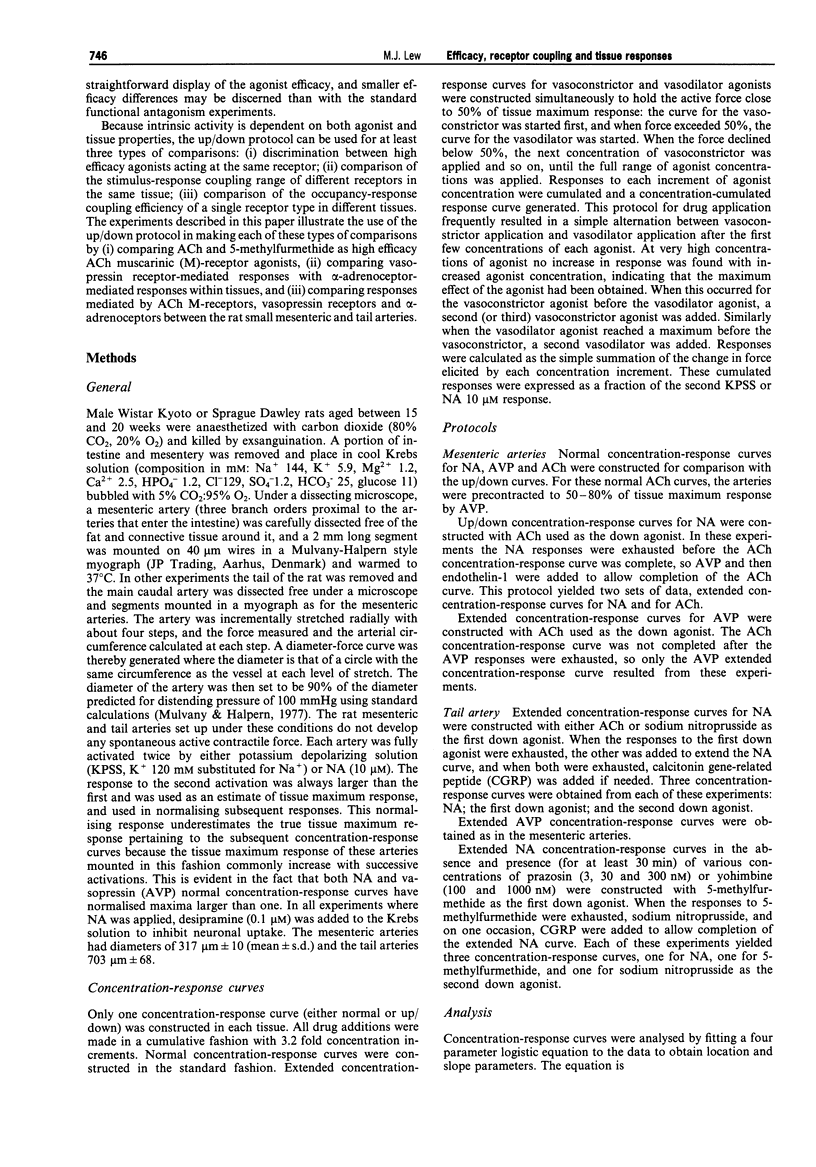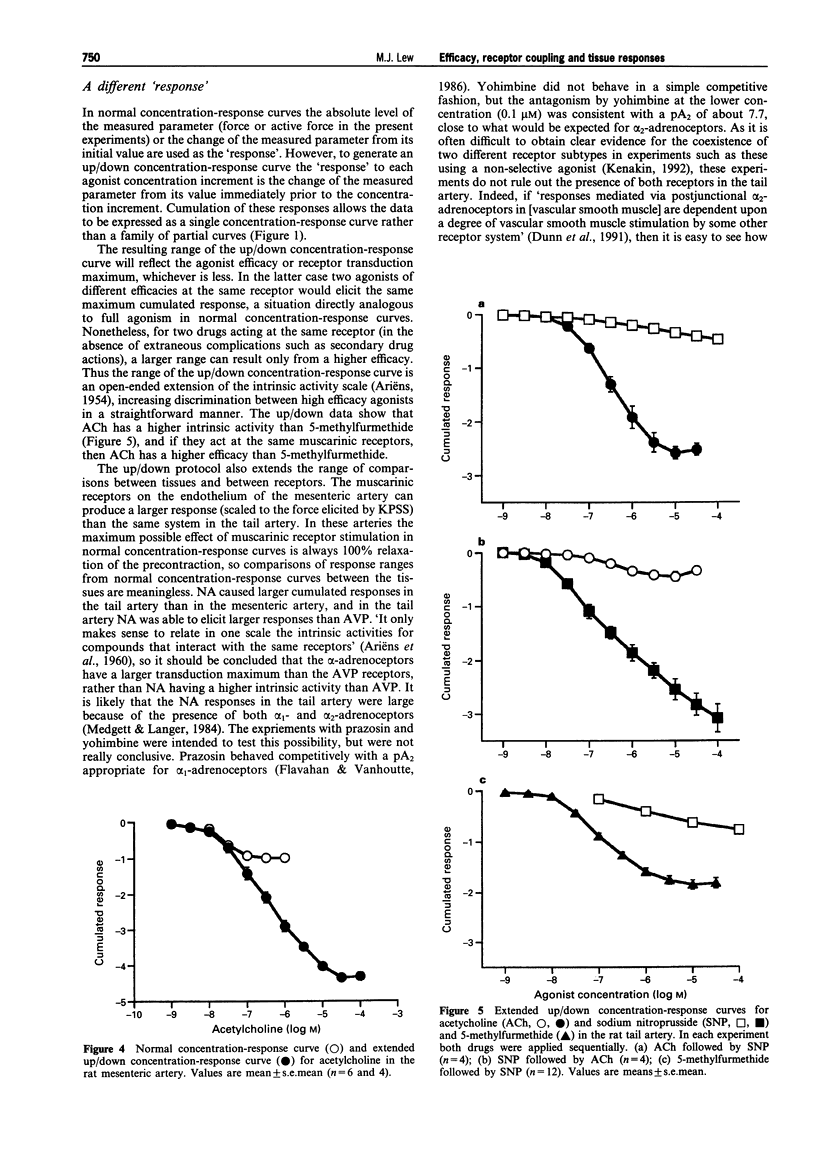Abstract
1. An approach is described for generating extended agonist concentration-response curves where the responses are unconstrained by the normal tissue maximum response. Functional antagonism is employed to hold the tissue state in the range where any change in stimulus can be translated into a measurable response. 2. The maximum response of these extended concentration-response curves provides an index of intrinsic activity reflecting the agonist efficacy and the receptor occupancy-response coupling range. 3. The use of this approach is illustrated with extended concentration-response curves for noradrenaline (NA), vasopressin, acetylcholine (ACh), and 5-methylfurmethide in the small mesenteric and tail arteries of the rat. Both NA and vasopressin can maximally activate the arteries, but the new protocol shows that NA can produce more cellular activation than vasopressin in the tail artery. Both ACh and 5-methylfurmethide are full agonists but ACh has a higher intrinsic activity than 5-methylfurmethide. The ACh muscarinic receptors in the mesenteric artery have a larger occupancy-response range than the ACh muscarinic-receptors in the tail artery, and the alpha-adrenoceptors in the tail artery appear to have a larger occupancy-response coupling range than those in the mesenteric artery. 4. This approach extends our ability to compare the efficacies of full agonists, and to compare the occupancy-response coupling ranges of receptors that can normally maximally activate the assay tissue. This is achieved without the use of an irreversible antagonist and should be applicable to many receptors and pharmacological assay systems where responses are stable and functional antagonists are available.
Full text
PDF







Selected References
These references are in PubMed. This may not be the complete list of references from this article.
- ARIENS E. J. Affinity and intrinsic activity in the theory of competitive inhibition. I. Problems and theory. Arch Int Pharmacodyn Ther. 1954 Sep 1;99(1):32–49. [PubMed] [Google Scholar]
- ARIENS E. J., van ROSSUM J., KOOPMAN P. C. Receptor reserve and threshold phenomena. I. Theory and experiments with autonomic drugs tested on isolated organs. Arch Int Pharmacodyn Ther. 1960 Sep 1;127:459–478. [PubMed] [Google Scholar]
- Besse J. C., Furchgott R. F. Dissociation constants and relative efficacies of agonists acting on alpha adrenergic receptors in rabbit aorta. J Pharmacol Exp Ther. 1976 Apr;197(1):66–78. [PubMed] [Google Scholar]
- Broadley K. J., McNeill J. H. Dissociation constants (KA) and relative efficacies of sympathomimetic amines in isolated atria during hypothermia-induced supersensitivity. Can J Physiol Pharmacol. 1983 Jun;61(6):572–580. doi: 10.1139/y83-088. [DOI] [PubMed] [Google Scholar]
- Broadley K. J., Nicholson C. D. Functional antagonism as a means of determining dissociation constants and relative efficacies of sympathomimetic amines in guinea-pig isolated atria. Br J Pharmacol. 1979 Jul;66(3):397–404. doi: 10.1111/j.1476-5381.1979.tb10844.x. [DOI] [PMC free article] [PubMed] [Google Scholar]
- Buckner C. K., Saini R. K. On the use of functional antagonism to estimate dissociation constants for beta adrenergic receptor agonists in isolated guinea-pig trachea. J Pharmacol Exp Ther. 1975 Sep;194(3):565–574. [PubMed] [Google Scholar]
- Dunn W. R., McGrath J. C., Wilson V. G. Postjunctional alpha-adrenoceptors in the rabbit isolated distal saphenous artery: indirect sensitivity to prazosin of responses to noradrenaline mediated via postjunctional alpha 2-adrenoceptors. Br J Pharmacol. 1991 Jun;103(2):1484–1492. doi: 10.1111/j.1476-5381.1991.tb09815.x. [DOI] [PMC free article] [PubMed] [Google Scholar]
- Emmerson J., Mackay D. A test of the null equation for functional antagonism. Br J Pharmacol. 1981 May;73(1):135–141. doi: 10.1111/j.1476-5381.1981.tb16782.x. [DOI] [PMC free article] [PubMed] [Google Scholar]
- Kenakin T. P. Tissue response as a functional discriminator of receptor heterogeneity: effects of mixed receptor populations on Schild regressions. Mol Pharmacol. 1992 Apr;41(4):699–707. [PubMed] [Google Scholar]
- Leff P., Martin G. R., Morse J. M. Application of the operational model of agonism to establish conditions when functional antagonism may be used to estimate agonist dissociation constants. Br J Pharmacol. 1985 Jul;85(3):655–663. doi: 10.1111/j.1476-5381.1985.tb10561.x. [DOI] [PMC free article] [PubMed] [Google Scholar]
- Lew M. J., Angus J. A. Wall thickness to lumen diameter ratios of arteries from SHR and WKY: comparison of pressurised and wire-mounted preparations. J Vasc Res. 1992 Nov-Dec;29(6):435–442. doi: 10.1159/000158962. [DOI] [PubMed] [Google Scholar]
- Mackay D. An analysis of functional antagonism and synergism. Br J Pharmacol. 1981 May;73(1):127–134. doi: 10.1111/j.1476-5381.1981.tb16781.x. [DOI] [PMC free article] [PubMed] [Google Scholar]
- Medgett I. C., Langer S. Z. Heterogeneity of smooth muscle alpha adrenoceptors in rat tail artery in vitro. J Pharmacol Exp Ther. 1984 Jun;229(3):823–830. [PubMed] [Google Scholar]
- Mulvany M. J., Halpern W. Contractile properties of small arterial resistance vessels in spontaneously hypertensive and normotensive rats. Circ Res. 1977 Jul;41(1):19–26. doi: 10.1161/01.res.41.1.19. [DOI] [PubMed] [Google Scholar]
- Ruffolo R. R., Jr, Zeid R. L. Relationship between alpha adrenoceptor occupancy and response for the alpha-1 adrenoceptor agonist, cirazoline, and the alpha-2 adrenoceptor agonist, B-HT 933, in canine saphenous vein. J Pharmacol Exp Ther. 1985 Dec;235(3):636–643. [PubMed] [Google Scholar]
- Stone M., Angus J. A. Developments of computer-based estimation of pA2 values and associated analysis. J Pharmacol Exp Ther. 1978 Dec;207(3):705–718. [PubMed] [Google Scholar]
- van den Brink F. G. The model of functional interaction. I. Development and first check of a new model of functional synergism and antagonism. Eur J Pharmacol. 1973 Jun;22(3):270–278. doi: 10.1016/0014-2999(73)90026-5. [DOI] [PubMed] [Google Scholar]


